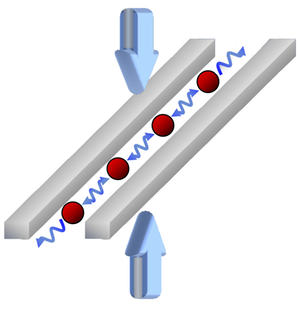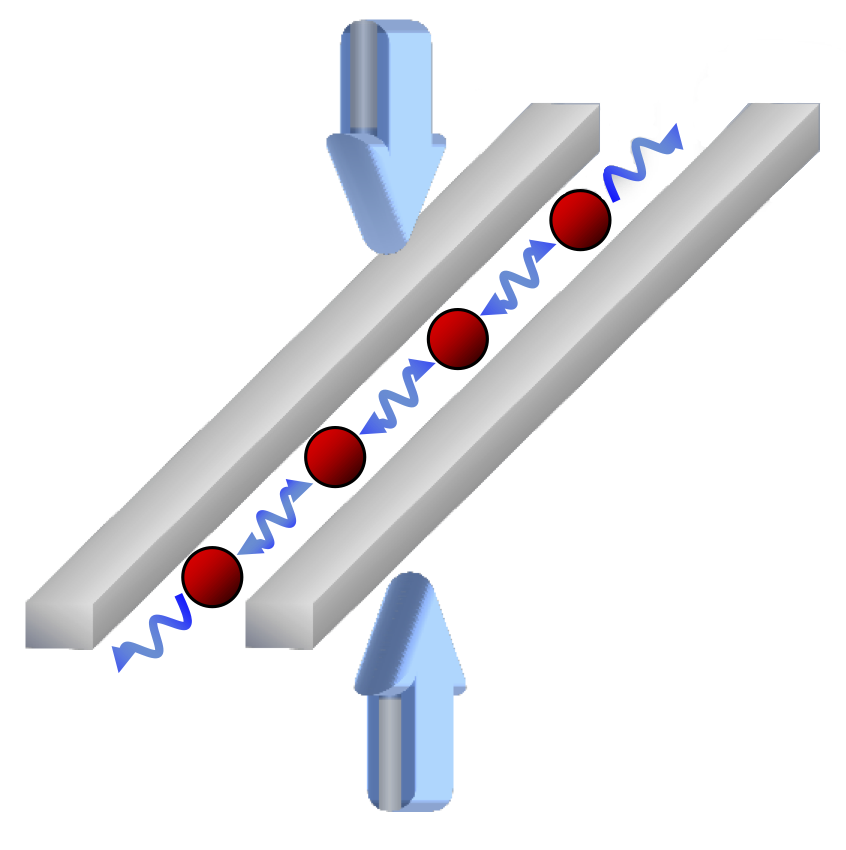Atoms Organize Themselves
Researchers have tried to mimic the behavior of atoms in solids by creating artificial crystals in which atoms are held in place by light. A new theory in Physical Review Letters proposes letting atoms self-organize into a crystalline arrangement, without the need for lasers to hold them in place. The model describes a single row of regularly spaced atoms—a one-dimensional crystal—that can form between a pair of parallel optical fibers. The atoms interact through photons that the fibers transmit from one atom to another. The technique could lead to new studies of self-organization in other systems and may one day help process quantum information.
In a so-called optical lattice, lasers provide a periodic pattern of points to which atoms are attracted. Atoms in such an array can behave like atoms in a crystal, except that researchers can precisely control the strength of the atomic interactions and other details. However, externally imposing static positions for the atoms prevents optical lattices from capturing some effects that occur when the atoms can influence their own lattice structure.
One way to induce interactions between atoms is to place them in the vicinity of a nanoscale optical fiber, or “nanophotonic waveguide.” These waveguides are very thin “light pipes” in which some of the electromagnetic field bleeds out into the space around them. Recent experiments showed that these overflow (or “evanescent”) fields can trap a row of atoms parallel to the waveguide, with the atom spacing determined by a standing wave pattern inside the waveguide [1]. To investigate atom self-organization, Darrick Chang of the Institute of Photonic Sciences (ICFO) in Barcelona, Spain, Ignacio Cirac of the Max Planck Institute for Quantum Optics in Garching, Germany, and Jeff Kimble of the California Institute of Technology in Pasadena, devised a model in which the atoms are essentially free to roam in one dimension but are fixed in the other two. The atoms are trapped in the small space between a parallel pair of nanoscale waveguides, where they form a single row.
To allow interactions between atoms, the researchers envision pump lasers applied from above and below the waveguide plane. When tuned to the right frequency, the lasers can excite transitions in the atoms from the ground state to the first excited state. An excited atom will subsequently drop back to the ground state by emitting a photon preferentially into the waveguides, which jointly convey the photon until it’s absorbed by another atom. This photon sharing allows the atoms to exchange momentum; it’s as if two atoms “collide” with each other by relaying photons through the waveguides. This arrangement increases the strength of the usual atomic interactions by allowing distant atoms to interact as easily as ones close by. “The effective force on one atom is the same no matter how far away the other atom is,” Chang says.
To determine how the atoms organize under this spatially independent interaction, the researchers first assume that the pump laser frequency is tuned slightly away from the optimal value for exciting atoms, so that the atoms and photons interact only weakly. In this “weak scattering” limit, the atoms form an evenly spaced row in between the waveguides, according to the team’s calculations.
The team then imagined increasing the atom-photon interaction strength. They found that—depending on the frequency of the laser—the lattice will expand or contract, or, surprisingly, split into two separate pieces of equal length. “We have found a rich set of behaviors related to self-organization and shown how their properties may be modified by simply changing some external parameters,” says Cirac. The team plans to explore how this self-organization might work in higher dimensions, where it might reproduce behavior in other systems, such as ordered electron configurations called Wigner crystals. Atoms in self-organizing lattices might also serve as light-controlled quantum bits (qubits) in quantum computers.
“Very innovative work,” says Helmut Ritsch of the University of Innsbruck in Austria. “As the spacing is not fixed by prescribed optical potentials,” he says, “this is a decisive step towards a true atom light crystal.” Arno Rauschenbeutel of the Vienna University of Technology says the proposed system is somewhat idealized, but “the results of this simplified model are sufficiently exciting to start working towards their experimental realization.”
–Michael Schirber
Michael Schirber is a Corresponding Editor for Physics Magazine based in Lyon, France.
References
- E. Vetsch, D. Reitz, G. Sagué, R. Schmidt, S. T. Dawkins, and A. Rauschenbeutel, “Optical Interface Created by Laser-Cooled Atoms Trapped in the Evanescent Field Surrounding an Optical Nanofiber,” Phys. Rev. Lett. 104, 203603 (2010)
More Information
I. Bloch, J. Dalibard, and W. Zwerger, “Many-Body Physics with Ultracold Gases,” Rev. Mod. Phys. 80, 885 (2008)





